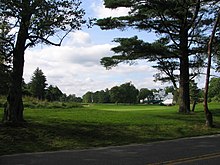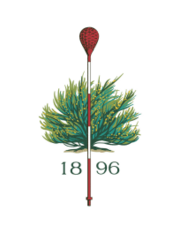|
Merion Golf Club
Merion Golf Club is a private golf club which is located in Haverford Township, Delaware County, Pennsylvania, a township bordering Philadelphia to the northwest along the historic Main Line. The club has two courses: the East Course, and the West Course. The East Course has been consistently rated in the top 10, #5 in 2015, by Golf Digest in the annual "America's 100 Greatest Golf Courses", and it has hosted five U.S. Opens, most recently in 2013. HistoryOriginal course Claus Johnson, the eldest son of John Johnson and Christina Skute, was born sometime prior to 1712 and died about 1786. He married, 30 March 1734, Rebecca Bankson, the daughter of Andrew Bankson Jr., and his wife Gertrude Boore. Claus and Rebecca were living in Neshaminy, Bensalem, Bucks County, Pennsylvania in 1740 when he contributed ten shillings to Gloria Dei, and also at the time of the church census on November 20, 1743. In 1744, they bought a farm in Haverford Township, now in Delaware County, from Amos Lewis. The East course of the Merion Golf Club now occupies that property and their former home is the clubhouse. Claus was a vestryman at Old St. Davids Church in Radnor from 1760 to 1770 and it is presumed that he is buried there. The Merion Golf Club came to being in 1896, when members of the Merion Cricket Club (founded in 1865) opened a golf course in Haverford Township, Pennsylvania. Two new coursesIn 1910, the membership decided to build a new course and chose thirty-two-year-old club member Hugh Wilson, a Princeton University graduate, and fine player, to design it. Merion East opened in September 1912, and the original course was closed. The West Course, also designed by Wilson, opened in May 1914. The Merion Golf Club did not officially separate from the Merion Cricket Club until 1941. Wilson's research pays offHugh Wilson had never designed a golf course, so he went on a seven-month trip to Scotland and England to study British courses. Several features of Merion East are derived from famous British courses, not the least of which are Merion's distinctive Scottish-style bunkers, which are now known as the "white faces of Merion" (named by top amateur player Chick Evans). Wilson's layout covers only 126 acres (0.51 km2) of land, a very small area for a golf course. It was ranked fifth in Golf Digest's "America's 100 Greatest Golf Courses" in 2015, and Jack Nicklaus has said of Merion East, "Acre for acre, it may be the best test of golf in the world." Wilson's designs were the first courses designed to provide both significant penalties (in terms of hazards and boundaries) for deviation from lines of play, and multiple possible means for reaching the pin from the tee. The West Course in particular is relatively little altered from Wilson's design, while the East Course has had alterations made to accommodate the widening of Ardmore Avenue. The club was designated a National Historic Landmark in 1992 for its contribution to these innovations in the sport.[5] Merion has held eighteen United States Golf Association (USGA) championship tournaments, more than any other course. The first two, the 1904 and 1909 U.S. Women's Amateurs, were held at the original Haverford course. The first USGA men's tournament held at the East Course was the 1916 U.S. Amateur, won by Chick Evans. This was also the first time Bobby Jones appeared in a national championship; he was fourteen years old. Jones would win his first U.S. Amateur in 1924, also held at Merion. Bobby Jones completes Grand SlamIn 1930, the U.S. Amateur returned to Merion in late September. Earlier that year, Bobby Jones had won the British Amateur, British Open, and U.S. Open, so anticipation was high to see if he could complete the sweep of all four major championships of the time,[6] the "impregnable quadrilateral."[7] Jones won the medal in the stroke play qualifier and cruised through the first four rounds of match play, to the final 36-hole match against Eugene Homans on Saturday. A gallery of 9,000 was on hand for the start of the match; this swelled to 18,000 by the afternoon round, forcing the competitors to be escorted to the tees and greens. After the morning round, Jones was comfortably ahead by seven holes, and when both players parred the 11th hole Jones had an 8 & 7 victory (eight holes ahead with seven to play).[8] Searching for words to describe the unprecedented feat, Atlanta newsman O. B. Keeler used the term "Grand Slam", which has stuck ever since. Seven weeks after the tournament, Bobby Jones retired from competitive golf at age 28. Hogan's comeback from accident Merion's 1950 U.S. Open was the site of Ben Hogan's comeback, sixteen months after a head-on collision with a bus which shattered his pelvis and nearly killed him.[9] On the 72nd hole (and 36th of the day), in extreme pain[10] and facing a shot of over 200 yards (180 m) into the wind, Hogan needed a par to force a playoff, as he had just bogeyed the long par-3 17th (and the par-4 15th). From the fairway, Hogan used a 1-iron to hit a superb shot which stopped on the distant green and two-putted from 40 feet (12 m) for par. Hogan then defeated Lloyd Mangrum and George Fazio in an 18-hole playoff on Sunday to win the tournament.[11] Hy Peskin's photograph of Hogan's 1-iron shot, taken from behind during Hogan's follow-through, is among the most famous pictures in golf.[9][12] Lost for over three decades, the club resurfaced in the early 1980s, and now resides in the USGA Museum.[13][14] The point on the 18th fairway where Hogan hit the famous shot is commemorated with a plaque.[15][16] Trevino defeats NicklausThe U.S. Open in 1971 at Merion resulted in another playoff, this time between Jack Nicklaus and Lee Trevino, arguably the top two players in the world at the time. Both had missed putts on the 72nd hole to win on Sunday, Trevino for par and Nicklaus for birdie. In the Monday playoff, Nicklaus had trouble early in the bunkers and was behind the rest of the round. Trevino, the 1968 champion, won by three strokes for his second U.S. Open title. It was the second of four times that Nicklaus was a runner-up to Trevino at a major championship. Strengthened course tests new generation Following David Graham's win at the U.S. Open at Merion in 1981, it was felt by many that the relatively short course of about 6,500 yards (5,940 m), small course area of 111 acres (45 ha) (which limits gallery size), and lack of grounds to hold corporate tents and other infrastructure would preclude Merion from holding a major again.[17] However, following some land acquisition nearby and lengthening of the East Course to nearly 7,000 yards (6,400 m), many of these concerns appeared to be addressed. After successfully hosting the U.S. Amateur in 2005, the USGA awarded a fifth U.S. Open to Merion, held in 2013, 32 years after its last hosting of the national championship.[17] Justin Rose captured his first major by posting a score of one-over-par 281 for 72 holes, good for a two-stroke victory over Phil Mickelson and Jason Day. Most of the players who competed in the 2013 Open had very high praise for the course, which featured long, difficult rough following a wet spring. The lowest 18-hole score for the tournament was three-under-par 67, posted by several players, including Mickelson. The course held up very well as a premium test of golf, in spite of pre-tournament worries from some golf media people that many low scores would be posted by the modern generation of players.[18] Wicker basketsOn the East Course, all pins are topped with wicker baskets instead of the usual flags (which are used on the West Course).[19] As one story goes, when Hugh Wilson was in England studying their golf courses, he happened upon local sheep herders and their flocks. These shepherds held staffs that they used for herding, and the staffs all had wicker baskets at the top. In those baskets, they kept their lunch for the day so that no animals could get into it. Wilson decided to use the idea at Merion, though the exact origin has never been fully verified.[20] One effect is that the baskets are visible even if the wind is not blowing – but they do not give the golfer any indication of wind direction at the green. They have been used since at least 1916,[20] and are featured in the club's logo.[21] The pin markers at Merion East have several other unique features. At 7 feet 6 inches (2.29 m), including the 14-inch-high (36 cm) baskets, they are 6 inches (15 cm) taller than standard flagsticks. The poles are solid metal instead of the standard fiberglass, and the baskets themselves are colored red on the first nine holes and orange on the second nine. Interestingly, the 1950 U.S. Open was the only USGA championship held at Merion East in which the pins were marked with flags instead of wicker baskets. In 2013, club historian John Capers indicated that he did not know the reason for the substitution, but speculated that it came about because a player in the previous year's U.S. Women's Amateur, held on the same course, was unnerved when her ball bounced off a basket during match play.[19] Up until around 1980, the wicker baskets were made on site by a member of the grounds crew staff. Since then, a woman, whose name and location in South Carolina are purposely kept anonymous, creates the current baskets.[22] Anyone who wins a USGA event at Merion receives a wicker basket top. Wickers are destroyed if the wicker baskets are broken. The golf course assistant superintendents collect the wickers every night, so they will not be stolen.[22] Tournaments at MerionMajor championships
^ 18 hole playoffs: 1950, 1971 Amateur championships
International team competitions
Scorecards
Merion Golf Club in popular cultureMerion Golf Club plays a prominent part in the novel "Back Spin" by Harlan Coben. The novel features a U.S. Open championship taking place at Merion Golf Club, during which the son of Jack Coldren, the golfer leading the pack, is kidnapped. It is also the inspiration for the name of the Marion Club in Mario Golf for the Game Boy Color. References
External links |
||||||||||||||||||||||||||||||||||||||||||||||||||||||||||||||||||||||||||||||||||||||||||||||||||||||||||||||||||||||||||||||||||||||||||||||||||||||||||||||||||||||||||||||||||||||||||||||||||||||||||||||||||||||||||||||||||||||||||||||||||||||||||||||||||||||||||||||||||||||||||||||||||||||||||||||||||||||||||||||||||||||||||||||||||||||||||||||||||||||||||||||||||||||||||||||||||||||||||||||||||||||||||||||||||||||||||||||||||||||||||||||||||||||||||||||||||||||||||||||||||||||||||||||||||||||||||||||||||||||||||||||||||||||||||||||||||||||||||||||||||||||||||||||||||




